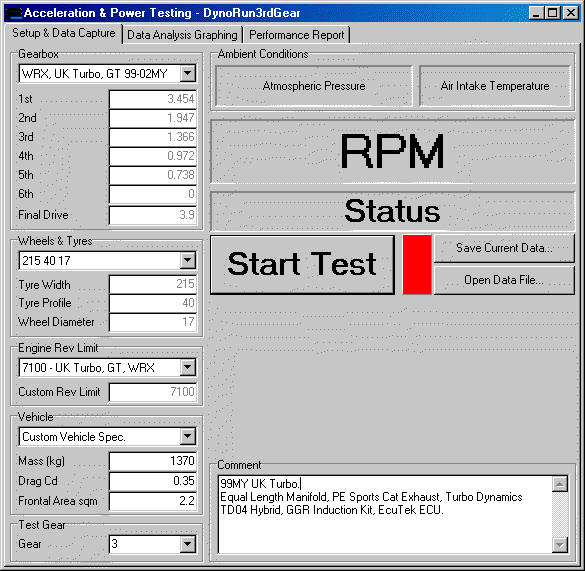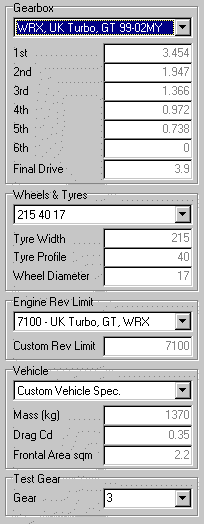| Live Data | XiDash | In-Car Dash |
XiTek XiDash Road Dyno feature (from hereon abbreviated to XiRD) allows real life performance testing of any manual transmission SUBARU vehicle supported by XiDash.
In addition, due to the way the XiRD does its calculations, it is unaffected by any piggyback ECUs or speed delimiter modules.


Use of XiRD is very simple. Before driving the car, the software must be setup with various physical characteristics of the vehicle in question, such as tyre size, gearbox type, rev limit, mass and drag data. These vehicle characteristics may be selected simply from lists of available options for the various car models. As long as you know the model of car you are driving, this is very simple to do.
Once this data has been entered, XiRD will display a graph showing the vehicle speeds achievable in each gear. This is as much as XiRD can tell you about your car until you perform an in gear test of the engine - see below.
Gathering performance data about the vehicle involves driving the vehicle from low engine revs (say 1000 RPM) up to any higher RPM that you choose. Before testing, ensure that you have selected the gear you have decided to test in - this is labelled 'Test Gear'. To perform the test, select the 'Setup & Data Capture' tab and from a steady crusing speed, when you are ready, click on start test. You must then reduce speed until the engine drops below 1250 RPM. Once the engine revs have dropped low enough, the test will begin. At this point, the driver must accelerate in the chosen gear. No gear changes, braking or clutching should be performed during this test - the test is from low revs to high revs in a single gear.
This will require two people - one to drive and one to operate the laptop But you can try to do this alone.

Once the performance test has been done, clicking on the 'Data Analysis Graphing' tab will display a vehicle performance graph. The axes of this graph may be altered to show a wide variety of statistics. The most common graph for comparing vehicles will be Power & Torque against Engine RPM or Vehicle Speed. Preferred units of measure may be selected at any time - Power in BHP, PS or kW, torque in Nm, LbFt or kgm. When viewing power & torque, the power is the bright line, whilst the torque is the more feint line.

Selecting the tab, 'Performance Report' shows various facts and figures about the car. These may be cut & pasted for use elsewhere.
Test data and the entered vehicle characteristics may be saved at any time using the 'Save Data�' button. Files may then be reloaded and edited using the 'Open Data File' button - this allows editing of the vehicle characteristics, should any previously entered data be found to be incorrect.
Up to four data files may be viewed simultaneously by using the 'Compare Files' panel to load in three further data files. The colours of each graph line is shown next to the name of each file loaded.
It is absolutely essential that the correct test gear is chosen in order to get accurate results. Using 'Test Gear', you must select the gear in which the test was performed.
Since XiRD uses engine RPM data to calculate vehicle performance, the characteristics of the gearbox & tyres must be specified so that XiRD can translate measured engine RPM into the correct vehicle speed. Tyre data is easy to ascertain. Simply look at the tyres on your car - they will have their dimensions printed on the side wall. Gearbox data, unless you've been doing serious modifications to your car, will be the same for all cars of a particular model - simply select the correct model from the list. If you have modified your car's gearbox, then you are the only one who should know this information!
In order to calculate the power & torque that the engine is generating based on this speed data, XiRD must also know the mass of the car - it is important to get this figure accurate, since the calculated power will vary in proportion to the mass entered. The mass specified should be the current mass of the vehicle at the time of the test.
The following variables will affect the current vehicle mass:
The book kerb weight should not be used. Get your vehicle weighed with a known amount of fuel in the tank. This may be done at a weighing bridge or by using corner weight scales for a really accurate reading.
Overestimating the vehicle mass will give a power figure that is too high. Underestimating the vehicle mass will do the opposite.
XiRD takes into account aerodynamic drag when calculating engine performance. Vehicle drag co-efficient and frontal area are the parameters required to calculate power lost to aerodynamic drag. Whilst important for accurate power calculations, these vehicle characteristics are far less important to measurement accuracy than the vehicle mass. Aerodynamic drag is quite small in 2nd & 3rd gear and so inaccuracies in these figures will only result in a small (2 or 3 BHP) error in calculated power. If power tests are performed in higher gears e.g. 4th, 5th or 6th, then the importance of these values becomes much greater. In the absence of definitive data, use a frontal area of 2.2 sqm and a drag co-efficient of 0.35.
The ECU's rev limit is only relevant when calculating the maximum speed possible in each gear. It is not used for any other performance calculations. Unless your car's ECU has been modified, then simply select the rev limit matching the model of your car.

When testing on the road, you know that the above variables are all real world quantities encountered on the road. Only if the operator of the rolling road can reproduce all of these effects as seen on the road will the rolling road performance figures be close to those actually encountered on the road. Having said that, in order to get accurate results using a road dyno method, it must be setup correctly, though this is much easier to achieve.
Zorge Boosters assisted in the development of this product. Power runs of the development vehice were taken on the rolling road. A figure of 227 wheel horse power was produced in 4th gear. Out on the road, using XiRD, figures of 222 & 233 horse power were produced in 2nd & 3rd gears respectively. From this test, it is clear that both methods of testing can produce very similar results.
For various technical reasons, it is not possible to accurately calculate flywheel horsepower using using XiRD. All performance figures are quoted in wheel power & torque - the actual power seen at the wheels. Most rolling roads are able to calculate flywheel horsepower resonably well - this is one reason why a visit to your local rolling road is worthwhile. Having said that, it is wheel horsepower that is relevant to the real world - this is the power that the vehicle is putting down onto the road. Just don't get flywheel and wheel power confused. If you get quoted two power figures, the wheel power is always the lower of the two.